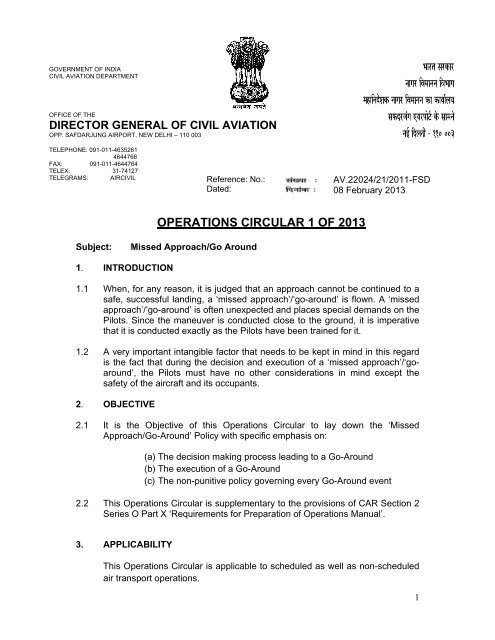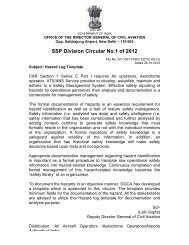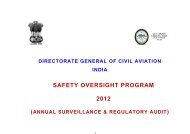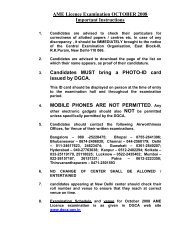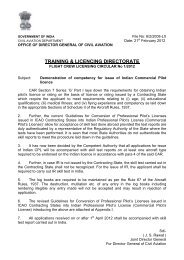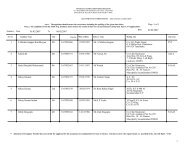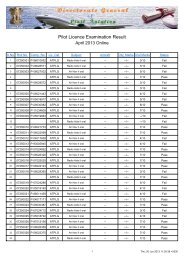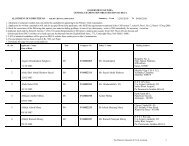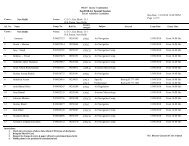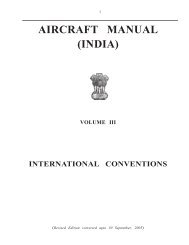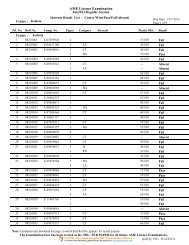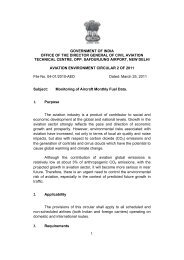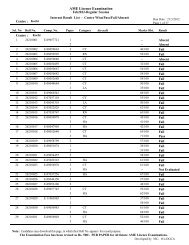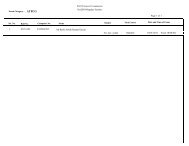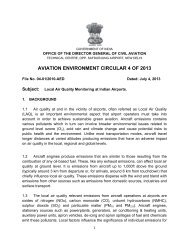Operations Circular 1 of 2013 - Missed Approach - Directorate ...
Operations Circular 1 of 2013 - Missed Approach - Directorate ...
Operations Circular 1 of 2013 - Missed Approach - Directorate ...
Create successful ePaper yourself
Turn your PDF publications into a flip-book with our unique Google optimized e-Paper software.
GOVERNMENT OF INDIACIVIL AVIATION DEPARTMENTOFFICE OF THEDIRECTOR GENERAL OF CIVIL AVIATIONOPP. SAFDARJUNG AIRPORT, NEW DELHI – 110 003TELEPHONE: 091-011-46352614644768FAX: 091-011-4644764TELEX: 31-74127TELEGRAMS: AIRCIVIL Reference: No.:Dated:AV.22024/21/2011-FSD08 February <strong>2013</strong>OPERATIONS CIRCULAR 1 OF <strong>2013</strong>Subject:<strong>Missed</strong> <strong>Approach</strong>/Go Around1. INTRODUCTION1.1 When, for any reason, it is judged that an approach cannot be continued to asafe, successful landing, a ‘missed approach’/‘go-around’ is flown. A ‘missedapproach’/‘go-around’ is <strong>of</strong>ten unexpected and places special demands on thePilots. Since the maneuver is conducted close to the ground, it is imperativethat it is conducted exactly as the Pilots have been trained for it.1.2 A very important intangible factor that needs to be kept in mind in this regardis the fact that during the decision and execution <strong>of</strong> a ‘missed approach’/‘goaround’,the Pilots must have no other considerations in mind except thesafety <strong>of</strong> the aircraft and its occupants.2. OBJECTIVE2.1 It is the Objective <strong>of</strong> this <strong>Operations</strong> <strong>Circular</strong> to lay down the ‘<strong>Missed</strong><strong>Approach</strong>/Go-Around’ Policy with specific emphasis on:(a) The decision making process leading to a Go-Around(b) The execution <strong>of</strong> a Go-Around(c) The non-punitive policy governing every Go-Around event2.2 This <strong>Operations</strong> <strong>Circular</strong> is supplementary to the provisions <strong>of</strong> CAR Section 2Series O Part X ‘Requirements for Preparation <strong>of</strong> <strong>Operations</strong> Manual’.3. APPLICABILITYThis <strong>Operations</strong> <strong>Circular</strong> is applicable to scheduled as well as non-scheduledair transport operations.1
4. DEFINITIONS4.1 <strong>Missed</strong> <strong>Approach</strong>/Go-Around is a maneuver conducted by a Pilot when anapproach cannot be completed to a landing.4.2 <strong>Missed</strong> <strong>Approach</strong>/Go-Around Phase <strong>of</strong> Flight is a sub phase <strong>of</strong> the<strong>Approach</strong> phase <strong>of</strong> flight. It starts from the first application <strong>of</strong> power after thecrew elects to execute a missed approach or go around until the aircraft reenters the sequence for a VFR pattern or until the aircraft reaches the IAF foranother approach (IFR).4.3 <strong>Missed</strong> <strong>Approach</strong> Point (MAP or MAPt) is the point prescribed ineach instrument approach at which a missed approach procedure shall beexecuted if the required visual reference does not exist.5. THE DECISION MAKING PROCESS LEADING TO A GO-AROUND5.1 When, for any reason, it is judged that an approach cannot be continued to asafe, successful landing, a missed approach or go-around is flown. Some <strong>of</strong>the reasons for discontinuing an approach include the following:(a) The ‘required visual reference’ has not been established bythe Decision Altitude/Height (DA/H) or Minimum DescentAltitude/Height (MDA/H) or is acquired but is subsequently lost;(b) The approach has become unstabilised;(c) The aircraft is not positioned so as to allow a controlled touch downwithin the designated runway touchdown zone with a consequent risk<strong>of</strong> aircraft damage with or without a Runway Excursion if the attempt iscontinued;(d) The runway is obstructed;(e) Landing clearance has not been received or is issued and latercancelled;The list above is illustrative and not exhaustive. It serves to illustrate the factthat to continue the approach under such circumstances is unsafe and adecision to execute a go-around is called for.5.2 A decision to go-around is usually taken by the PIC but may be taken byeither Pilot. Once a go-around decision is taken, it must be announced (byeither Pilot) with a clear and loud call <strong>of</strong> “Go-Around”.5.3 After the call <strong>of</strong> “Go-Around”, there must be no hesitation. The complete set <strong>of</strong>actions for the missed approach must then be systematically completed till theaircraft reaches the end <strong>of</strong> the missed approach phase <strong>of</strong> flight.2
6. THE EXECUTION OF A GO-AROUND6.1 A go-around from an instrument approach should follow the complete,published missed approach procedure unless otherwise instructed by airtraffic control.6.2 A go-around from a Visual Circuit/ <strong>Approach</strong> should follow the pre-briefedpath until level <strong>of</strong>f at Planned Height/Altitude assigned by ATC.6.3 The missed approach should normally be initiated not lower than the DA/H inprecision approach procedures, or at a specified point in non-precisionapproach procedures not lower than the MDA/H. However, a missedapproach can be executed below the DA/H, MDA/H for any reason if in thejudgment <strong>of</strong> either Pilot; the approach cannot be continued to a safe,successful landing.6.4 If a missed approach is initiated before arriving at the missed approach point(MAPt), it is important that the pilot proceeds to the MAPt (or to the middlemarker fix or specified DME distance for precision approach procedures) andthen follows the missed approach procedure in order to remain within theprotected airspace. The MAPt may be overflown at an altitude/height greaterthan that required by the procedure; but in the case <strong>of</strong> a missed approach witha turn, the turn must not take place before the MAPt, unless otherwisespecified in the procedure.6.5 When a go-around is initiated with the aircraft in landing configuration, a loss<strong>of</strong> altitude is inevitable while the engine accelerates and the pitch change andincreased power take effect. If the aircraft speed is below the final approachspeed (VAPP), the situation may be unstable, necessitating extra power tomaintain that speed. When speed or thrust are low, or decreasing, or acombination <strong>of</strong> these, the loss <strong>of</strong> altitude after selection <strong>of</strong> go-around power ismany times greater than if the speed VAPP was maintained and the powerstable6.6 Many go-arounds are conducted because the required visual references havenot been established when the aircraft reaches the DA/H or minimum descentheight MDA/H. When approaching the DA/H or MDA/H, the followingprinciples should be applied:(a) When approaching the MDA/H or the DA/H, the PF attempts to acquire therequired visual references. The PM stays head down, maintainsinstrument references and is ready to make appropriate calls if any flightparameter (airspeed, pitch attitude, bank angle, thrust) deviates from thenormal value. During this time, the PF is in almost-visual flying conditions.(b) If a go-around is initiated, an immediate transition to instrument flyingshould occur.(c) It is, therefore, <strong>of</strong> primary importance that the PM maintains instrumentreferences and is ready to make appropriate calls if any flight parameter(airspeed, pitch attitude, bank angle, thrust) deviates from the normalvalue.3
(d) To ease this transition back to instrument flying, all efforts should be madeto initiate the go-around with wings level and with no roll rate.7. THE NON-PUNITIVE POLICY GOVERNING EVERY GO-AROUND EVENT7.1 By definition, ‘missed approach’/‘go-around’ is flown when it is judged that anapproach cannot be continued to a safe, successful landing. As a logicalconsequence <strong>of</strong> this definition, a very important intangible factor that needs tobe kept in mind is the fact that during the decision and execution <strong>of</strong> a ‘missedapproach’/‘go-around’, the Pilots must have no other considerations in mindexcept the safety <strong>of</strong> the aircraft and its occupants.7.2 The Pilots must be secure in the knowledge that a ‘missed approach’/‘goaround’event does not call for any punitive action either by the Air Operatoror the DGCA.7.3 All aircraft operators (scheduled and non-scheduled) shall state in theirrespective <strong>Operations</strong> Manual, their Policy regarding non-punitive action withrespect to ‘missed approach’/‘go-around’ events.7.4 A ‘missed approach’/‘go-around’ maneuver initiated above MDA/H or theDA/H does not require to be reported.7.5 A ‘missed approach’/‘go-around’ initiated below MDA/H or the DA/H will notbe classified as an incident. However, such events may be examined but shallnot invite any punitive action. Reports on go-around below MDA/H or DA/Hshall be for data collection only.8. RESPONSIBILITY OF OPERATORSAll operators shall include in their <strong>Operations</strong> Manual and other relevantdocuments reference to non-punitive action for any go-around that is carriedout in the interest <strong>of</strong> safety. Pilots need to be encouraged to go-aroundirrespective <strong>of</strong> the altitude or height above threshold when flight parameters orenvironmental conditions preclude a safe approach and landing.9. GENERALThis <strong>Operations</strong> <strong>Circular</strong> supersedes the following <strong>Circular</strong>s;(a) <strong>Operations</strong> <strong>Circular</strong> 3 <strong>of</strong> 1996(b) Air Safety <strong>Circular</strong> 1 <strong>of</strong> 1991Sd/-(Capt Arvind Kathpalia)Flight <strong>Operations</strong> InspectorFor Director General <strong>of</strong> Civil AviationTo: All Scheduled and Non-Scheduled Operators4


